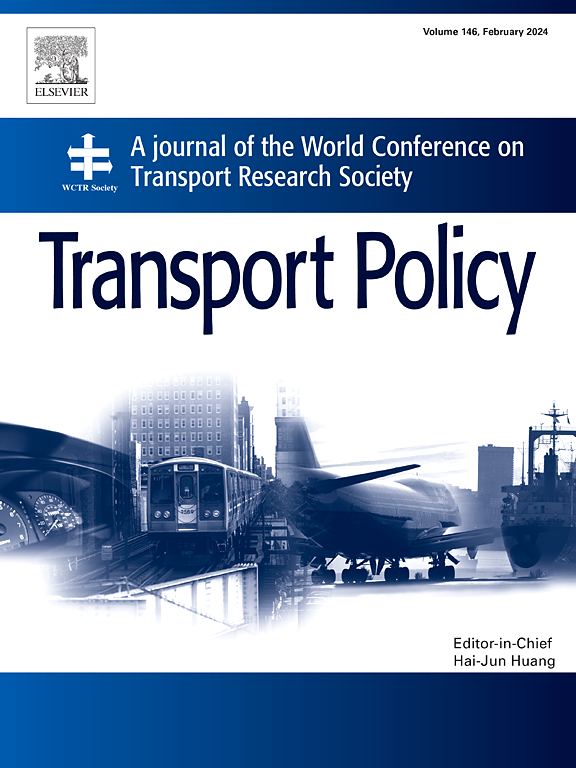Passenger arrival patterns and its implications for bus operation: The impact of schedule reading behavior on average waiting times at bus stops
IF 6.3
2区 工程技术
Q1 ECONOMICS
引用次数: 0
Abstract
Inaccuracies in measuring passenger waiting times at bus stops can lead to significant inefficiencies in optimizing bus operation schemes. To address this issue, this paper introduces a refined methodology aimed at accurately representing passenger waiting times and estimating the distributions of passenger arrival patterns at bus stops, with a focus on low-frequency suburban buses, considering their schedule-reading behaviors. First, we conducted stated preference (SP) and revealed preference (RP) surveys to capture the factors affecting passengers’ arrival behaviors, revealing that bus vehicle headway and bus arrival punctuality (quantified as the standard deviation of arrival time deviations, SD-BATD) significantly influence passenger behavior. Second, we developed models to assess the proportions of schedule-reading passengers (SR-passengers) and their average waiting time (AWT) as well as standard deviation (SD-WT). By treating AWT and SD-WT as independent variables, we then characterized the arrival patterns of both SR-passengers and schedule-neglecting passengers (SN-passengers) using maximum extreme value and uniform distributions, respectively. Additionally, we conducted numerical experiments on bus headway optimization to validate the operational implications of the proposed model for bus services. The results demonstrate that the AWT model significantly reduces bus operation costs by up to 15.7% compared to the traditional assumption that AWT = 1/2 headway. This effect is particularly pronounced for routes characterized by lower demand and higher speeds, which are typical of low-frequency suburban buses. Furthermore, this paper highlights the importance of accurately estimating the passenger waiting times considering passenger schedule-reading behavior in optimizing bus services.
乘客到达模式及其对公交运营的影响:时刻表阅读行为对公交站点平均等待时间的影响
在巴士站测量乘客等待时间的不准确性会导致优化巴士运营方案的效率显著降低。为了解决这一问题,本文引入了一种改进的方法,旨在准确地表示乘客等待时间并估计乘客到达站点的分布模式,重点关注低频郊区公交车,考虑他们的时间表阅读行为。首先,我们进行了陈述偏好(SP)和显示偏好(RP)调查,以捕捉乘客到达行为的影响因素,发现公交车车辆车头距和公交车到达正点率(量化为到达时间偏差的标准差,SD-BATD)显著影响乘客的行为。其次,我们建立了模型来评估阅读时刻表乘客(sr -passenger)的比例及其平均等待时间(AWT)和标准差(SD-WT)。以AWT和SD-WT为自变量,分别利用极大极值和均匀分布对sr -乘客和sn -乘客的到达模式进行了表征。此外,我们还对公交车车头时距优化进行了数值实验,以验证所提出的模型对公交车服务的运营影响。结果表明,与传统假设AWT = 1/2车头时距相比,AWT模型可显著降低公交车运营成本,最高可达15.7%。这种影响在需求较少、速度较快的路线上尤其明显,这些路线是典型的低频郊区公交车。此外,本文还强调了在考虑乘客读表行为的情况下,准确估计乘客等待时间对优化公交服务的重要性。
本文章由计算机程序翻译,如有差异,请以英文原文为准。
求助全文
约1分钟内获得全文
求助全文
来源期刊

Transport Policy
Multiple-
CiteScore
12.10
自引率
10.30%
发文量
282
期刊介绍:
Transport Policy is an international journal aimed at bridging the gap between theory and practice in transport. Its subject areas reflect the concerns of policymakers in government, industry, voluntary organisations and the public at large, providing independent, original and rigorous analysis to understand how policy decisions have been taken, monitor their effects, and suggest how they may be improved. The journal treats the transport sector comprehensively, and in the context of other sectors including energy, housing, industry and planning. All modes are covered: land, sea and air; road and rail; public and private; motorised and non-motorised; passenger and freight.
 求助内容:
求助内容: 应助结果提醒方式:
应助结果提醒方式:


